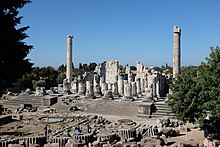Didyma
Δίδυμα | |
 | |
 Shown within Turkey | |
| Location | Didim, Aydin Province, Turkey |
|---|---|
| Region | Aegean Region |
| Coordinates | 37°23′06″N 27°15′23″E / 37.38500°N 27.25639°ECoordinates: 37°23′06″N 27°15′23″E / 37.38500°N 27.25639°E |
| Type | Sanctuary |
| History | |
| Founded | 8th century B.C.E. |
| Abandoned | C.E. 1493 |
| Cultures | Greek, Roman |
| Satellite of | Miletus |
| Site notes | |
| Condition | Ruined |
| Ownership | Public |
| Public access | Yes |
| Website | Didyma Archaeological Site |
Didyma (/ˈdɪdɪmə/; Ancient Greek: Δίδυμα) was an ancient Greek sanctuary on the coast of Ionia in the domain of the famous city of Miletus. Apollo was the main deity of the sanctuary of Didyma, also called Didymaion. But it was home to both of the temples dedicated to the twins Apollo and Artemis. Other deities were also honoured within the sanctuary. The Didymaion was well renowned in antiquity because of its famed oracle. This oracle of Apollo was situated within what was, and is, the one of the world's greatest temples to Apollo. The remains of this Hellenistic temple belong to the best preserved temples of classical antiquity. Besides this temple other buildings existed within the sanctuary which have been rediscovered recently; a Greek theatre and the foundations of the above-mentioned Hellenistic temple of Artemis, to name but two.[1]
Geography[]

The ruins of Didyma are located a short distance to the northwest of modern Didim in Aydin Province, Turkey, whose name is derived from the ruins. It sits on a headland that in antiquity formed the Milesian Peninsula. Didyma was the largest and most significant sanctuary on the territory of the great classical city Miletus. The natural connection between Miletus and Didyma was by way of ship. But during antiquity the sediments from the Meander River silted up the harbour of Miletus. A slow process which eventually meant that the nearby Latmian Gulf developed from a bay into a lake (today Bafa Gölü).[2]
The linear distance between Miletus and Didyma measures some 16 km. As well as the simple footway there also existed a Sacred Way between the city and its sanctuary which measured some 20 km in distance. This Sacred Way, built in the 6th century BC, was used for festival processions.[3] It touched the harbour of Didyma, situated 3 km northwest of the sanctuary called Panormos[4] (today Mavişehir). Along this route were ritual waystations, and statues of noblemen and noblewomen, as well as animal and mythological beast figures. Some of these statues, dating to the 6th century BC, are now in the British Museum (Room 13), excavated by the British archaeologist Charles Thomas Newton in the 19th century.[5]


The Milesians erected an altar dedicated to Poseidon 6 km southwest of Didyma. The altar was built in the first half of the 6th century BC at the southwest cape of the Milesian Peninsula. Here was the border between Ionia and Caria (according to Strabo[7]). The remains of the altar are still visible and can be easily found due to the location of a nearby modern lighthouse. Architectural members of this famous altar can be seen in the Pergamon Museum of Berlin.[8]
Names[]
In Greek didyma means "twin", but the Greeks who sought a "twin" at Didyma ignored the Carian origin of the name.[9] The Carians settled this area before the Ionian Greeks. Didyma was first mentioned among the Greeks in the Homeric Hymn to Apollo.[10] But its establishment is supposed to precede literacy and even the Hellenic colonization of Ionia around 1000 BC. In contrary the first archaeological pieces of evidence of Didyma date in the 8th century BC.[11]
Mythic genealogies of the origins of the Branchidae line of priests, designed to capture the origins of Didyma as a Hellenic tradition, date to the Hellenistic period.[12] Greek and Roman authors laboured to refer the name Didyma to "twin" temples or to temples of the twins Apollo and Artemis, whose own cult center at Didyma had then only recently been established.[13] Also, as Wilamowitz suggested,[14] there may be a connection to Cybele Dindymene, the "Cybele of Mount Dindymon". Excavations by German archaeologists have lately uncovered the temple dedicated to Artemis, north of the temple of Apollo.
Apollo was worshipped in nearby Miletus under the name Delphinius (the same name was also used at Delphi).[15] At Didyma, he was worshipped as Didymeus (Διδυμευς). His other names in the area were Philesios, Helios, and Carinus (Καρινος).[16]
History[]



It is supposed that until its destruction by the Persians in 494 BC, Didyma's sanctuary was administered by the family of the Branchidae, who claimed descent from an eponymous Branchos (Carian:
